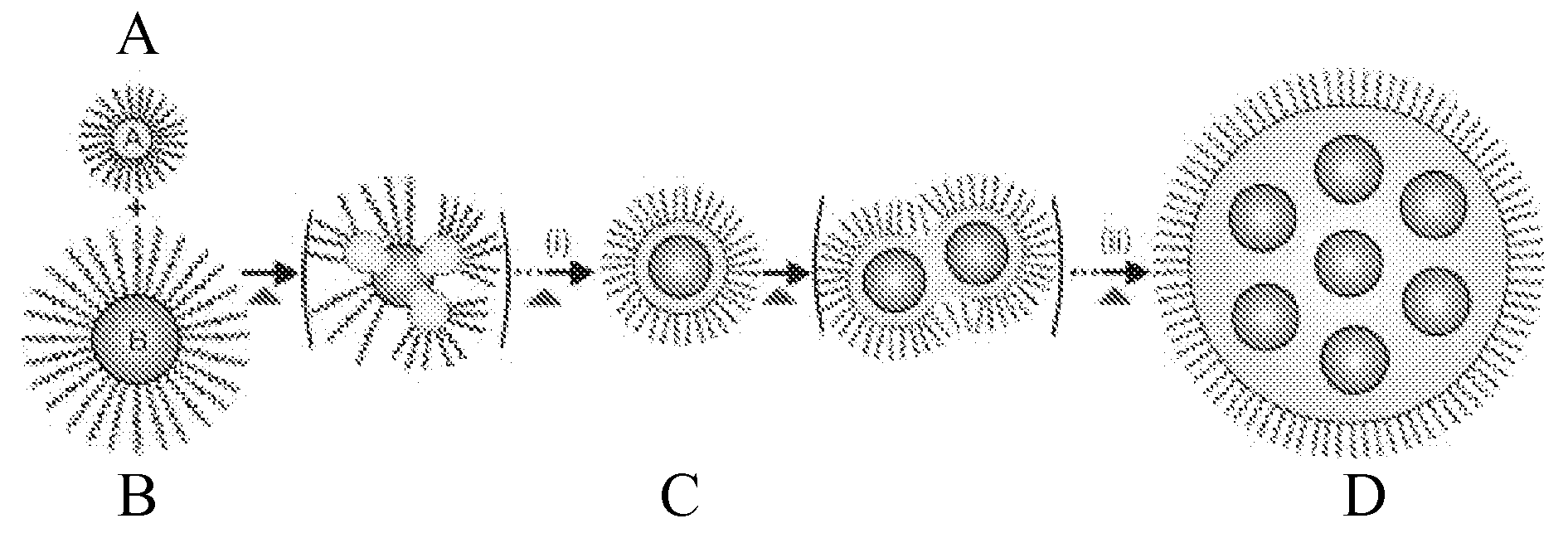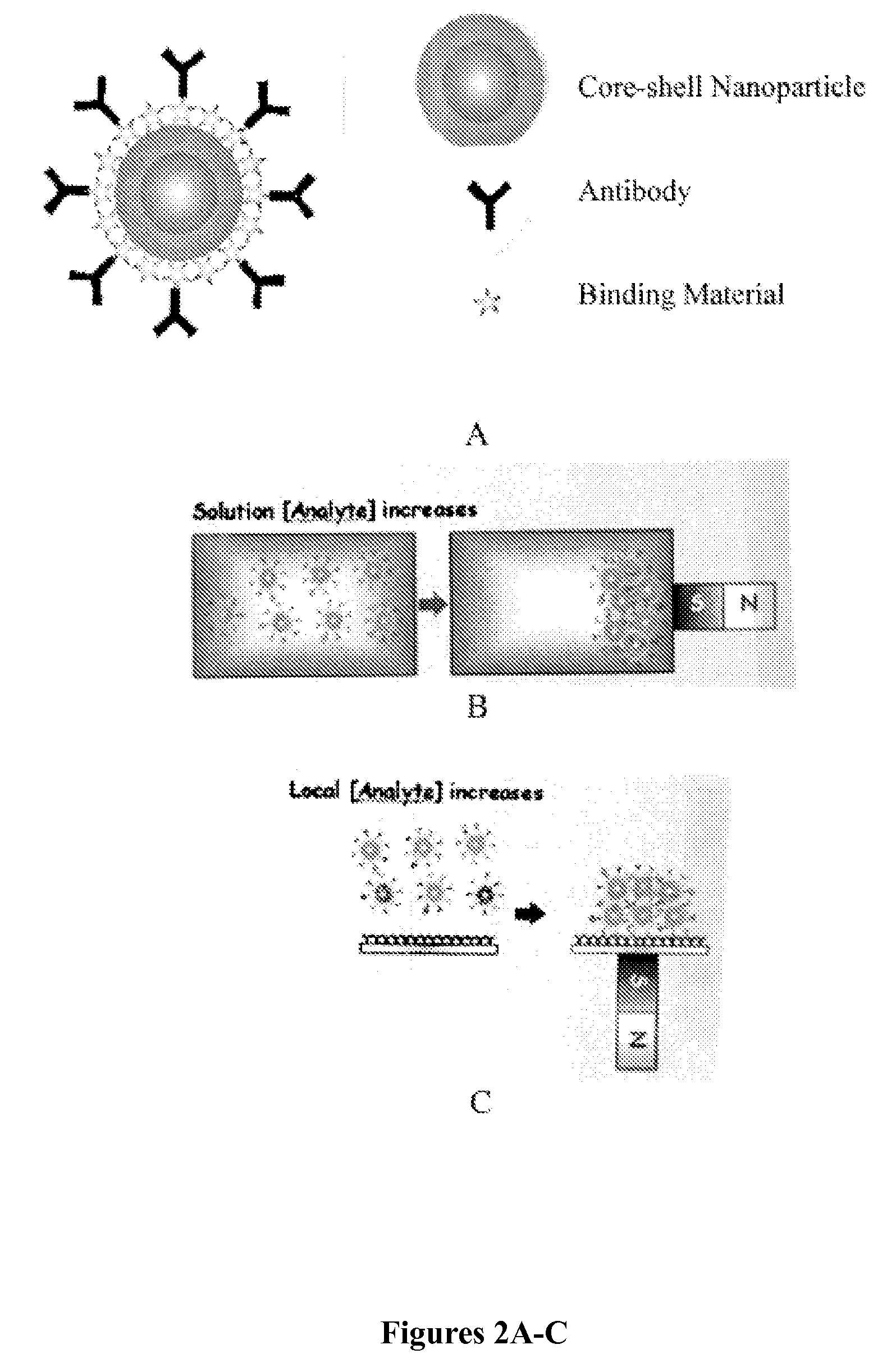Core-shell nanoparticles with multiple cores and a method for fabricating them
a technology of core-shell nanoparticles and nanoparticles, which is applied in the field of core-shell nanoparticles with multiple cores, can solve the problems of limited magnetic core or shell dimensions to 15 nm, lack of flexibility in surface modification and biocompatibility, and limitations that pose serious barriers to magnetic applications. achieve the effect of simple and effectiv
- Summary
- Abstract
- Description
- Claims
- Application Information
AI Technical Summary
Benefits of technology
Problems solved by technology
Method used
Image
Examples
example 1
Chemicals
[0048]Iron pentacarbonyl (Fe(CO)5), phenyl ether, trimethylamine oxide, decanethiol (DT) tetraoctylammonium bromide (TOA-Br), oleylamine (OAM), oleic acid (OA), trimethylamine oxide dihydreate ((CH3)3NO.2H2O), bovine serum albumin (BSA), 11-mercaptoundecanoic acid (MUA), mercaptobenzoic acid (MBA), dithiobis (succinimidyl propionate) (DSP), and other solvents (hexane, toluene, and ethanol) were obtained form Aldrich and were used as received. Anti-rabbit IgG and rabbit IgG were purchased from Pierce. Protein A and gold nanoparticles were obtained from Ted Pella.
example 2
Synthesis and Preparation
[0049]Fe2O3 (γ-Fe2O3) nanoparticles and Au nanoparticles were synthesized by known protocols, whereas the preparation of Fe2O3@Au nanoparticles was based on a new protocol developed in this work. For the synthesis of Fe2O3 nanoparticles, Fe2O3 nanoparticles capped with OA (and / or OAM) were prepared based on the modified procedure reported previously (Wang et al., J. Phys. Chem. B 109:21593 (2005), which is hereby incorporated by reference in its entirety). Briefly, 0.74 mL of Fe(CO)5 and 5.3 mL of OA (and / or OAM) in 40 mL of phenyl ether was stirred at 100° C. under argon purge. The solution was heated to 253° C. and refluxed for 1 h. The solution turned to dark brown. After the solution was cooled to room temperature, 1.26 g of (CH3)3NO.2H2O was added and stirred at 130° C. for 2 h. Temperature was increased to 253° C. and refluxed for 2 h. The reaction solution was stirred overnight. The resulting nanoparticles were precipitated with ethanol and rinsed mul...
example 3
Preparation of Nanoparticles Capped with Proteins and SERS Labels
[0051]The as-synthesized DT-capped iron oxide Au particles were transferred to water by ligand exchange using mercaptoundecanoic acid (MUA) by following a procedure reported by Gittins et al. (Chem. Phys. Chem. 3(1):110-113 (2002), which is hereby incorporated by reference in its entirety), with a slight modification. The nanoparticles were further modified with DSP for protein coupling by ligand exchange. To 1 mL solution of DT-capped iron oxide@Au particles (6 ng / mL) in borate buffer (pH 8.3), 140 μL of 1 mM DSP was added and stirred overnight. The nanoparticles were rinsed with centrifuge and 20 μL of anti-Rabbit IgG (2.4 mg / mL) was pipetted. After overnight incubation, the particles were centrifuged three times and finally resuspended in 2 mM Tris buffer (pH 7.2) with 1% BSA and 0.1% Tween 80. The same method was also used for coating protein A and BSA to Au nanoparticles of 80 nm size. 2.5 μL of 1 mM DSP was added...
PUM
| Property | Measurement | Unit |
|---|---|---|
| diameters | aaaaa | aaaaa |
| temperature | aaaaa | aaaaa |
| sizes | aaaaa | aaaaa |
Abstract
Description
Claims
Application Information
 Login to View More
Login to View More - R&D
- Intellectual Property
- Life Sciences
- Materials
- Tech Scout
- Unparalleled Data Quality
- Higher Quality Content
- 60% Fewer Hallucinations
Browse by: Latest US Patents, China's latest patents, Technical Efficacy Thesaurus, Application Domain, Technology Topic, Popular Technical Reports.
© 2025 PatSnap. All rights reserved.Legal|Privacy policy|Modern Slavery Act Transparency Statement|Sitemap|About US| Contact US: help@patsnap.com



